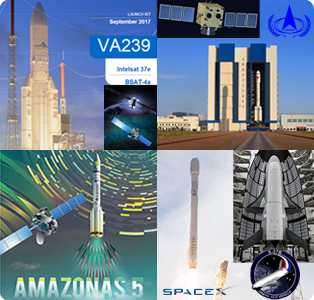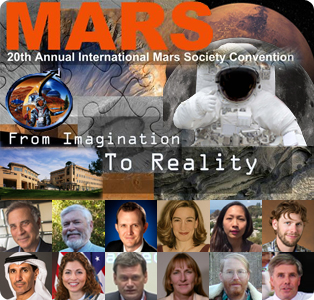Arianespace, CNSA, SpaceX and ILS Set for Upcoming Launches
|
MONDAY Ongoing…
|

![]() = All times
= All times
for terrestrial events in local time unless noted.
![]() = All times for international terrestrial events in local time unless noted.
= All times for international terrestrial events in local time unless noted.
![]() = All times for space events, and…
= All times for space events, and…
![]() = All times for international space / astro events in Hawaii Standard Time unless noted. Add 10 hours to obtain UT (‘Universal Time;’ Greenwich, England).
= All times for international space / astro events in Hawaii Standard Time unless noted. Add 10 hours to obtain UT (‘Universal Time;’ Greenwich, England).
Weekly Planet Watch – Evening Planets: Jupiter (W), Saturn (SW), Uranus (E), Neptune (SE); Morning Planets: Mercury (ESE), Mars (ESE), Venus (E).
Mars Society 20th Convention Focuses on Recent Science, Tech, Developments
|
Continued from…
|
TUESDAY
![]() Sep 5 — Voyager 1, Interstellar Space: NASA spacecraft begins 41st year in space today, launched Sep 5, 1977; farthest spacecraft from Earth, first to reach interstellar space.
Sep 5 — Voyager 1, Interstellar Space: NASA spacecraft begins 41st year in space today, launched Sep 5, 1977; farthest spacecraft from Earth, first to reach interstellar space.
![]() Sep 5 — Arianespace, Launch Ariane 5 / Intelsat 37e & BSAT 4a, Kourou, French Guiana: Arianespace Ariane 5 ECA rocket, designated VA239, to launch Intelsat 37e and BSAT 4a communications satellites
Sep 5 — Arianespace, Launch Ariane 5 / Intelsat 37e & BSAT 4a, Kourou, French Guiana: Arianespace Ariane 5 ECA rocket, designated VA239, to launch Intelsat 37e and BSAT 4a communications satellites
![]() Sep 5 — JPL, NASA/Caltech, Pasadena CA / Online: Winning #MessageToVoyager beamed to interstellar space.
Sep 5 — JPL, NASA/Caltech, Pasadena CA / Online: Winning #MessageToVoyager beamed to interstellar space.
![]() Sep 5 — Lunar and Planetary Laboratory, University of Arizona, Tucson AZ: Colloquium: From Pebbles to Planets; Katherine Kretke from SwRI, 15:45.
Sep 5 — Lunar and Planetary Laboratory, University of Arizona, Tucson AZ: Colloquium: From Pebbles to Planets; Katherine Kretke from SwRI, 15:45.
![]() Sep 5-7 — ESA, University of Warwick, Warwick, United Kingdom: The PLATO Mission Conference 2017: Exoplanetary systems in the PLATO Era.
Sep 5-7 — ESA, University of Warwick, Warwick, United Kingdom: The PLATO Mission Conference 2017: Exoplanetary systems in the PLATO Era.
![]() Sep 5-7 — German Aerospace Center (DLR), ESA, Torino, Italy: 22nd Workshop on Radiation Monitoring for the International Space Station.
Sep 5-7 — German Aerospace Center (DLR), ESA, Torino, Italy: 22nd Workshop on Radiation Monitoring for the International Space Station.
![]() Sep 5 — Mars: 0.70° NNE of Regulus, 02:00.
Sep 5 — Mars: 0.70° NNE of Regulus, 02:00.
![]() Sep 5 — Moon: 0.74° SSE of Neptune, 19:00.
Sep 5 — Moon: 0.74° SSE of Neptune, 19:00.
![]() Sep 5 — Apollo Asteroid 2017 QO: Near-Earth Flyby (0.087 AU).
Sep 5 — Apollo Asteroid 2017 QO: Near-Earth Flyby (0.087 AU).
WEDNESDAY
![]() Sep 6 — CNSA, Launch Long March 2D / VRSS 2, Jiuquan, China: Long March 2D rocket to launch 2nd Venezuelan Remote Sensing Satellite VRSS 2 built by China to collect imagery of Earth for Venezuela for scientific research, national security, disaster response applications.
Sep 6 — CNSA, Launch Long March 2D / VRSS 2, Jiuquan, China: Long March 2D rocket to launch 2nd Venezuelan Remote Sensing Satellite VRSS 2 built by China to collect imagery of Earth for Venezuela for scientific research, national security, disaster response applications.
![]() Sep 6-7 — Outer Planets Assessment Group (OPAG), NASA, La Jolla CA: Outer Planets Assessment Group (OPAG) Meeting; at Samuel H. Scripps Auditorium.
Sep 6-7 — Outer Planets Assessment Group (OPAG), NASA, La Jolla CA: Outer Planets Assessment Group (OPAG) Meeting; at Samuel H. Scripps Auditorium.
![]() Sep 6-19 — University of Evora, European Council for Nuclear Research (CERN), Evora, Portugal: 2017 European School of High-Energy Physics.
Sep 6-19 — University of Evora, European Council for Nuclear Research (CERN), Evora, Portugal: 2017 European School of High-Energy Physics.
![]() Sep 6 — Moon: Full (Corn / Barley Moon), 21:04.
Sep 6 — Moon: Full (Corn / Barley Moon), 21:04.
THURSDAY
![]() Sep 7 — SpaceX, Launch Falcon 9 / X-37B OTV-5, LC-39A KSC FL: SpaceX Falcon 9 to launch U.S. Air Force X-37B spaceplane Orbital Test Vehicle on its fifth mission.
Sep 7 — SpaceX, Launch Falcon 9 / X-37B OTV-5, LC-39A KSC FL: SpaceX Falcon 9 to launch U.S. Air Force X-37B spaceplane Orbital Test Vehicle on its fifth mission.
![]() Sep 7 — Library of Congress Science, Technology and Business Division, Washington DC: Lecture: Cassini’s Grand Finale; by Conor Nixon, NASA.
Sep 7 — Library of Congress Science, Technology and Business Division, Washington DC: Lecture: Cassini’s Grand Finale; by Conor Nixon, NASA.
![]() Sep 7 — British Interplanetary Society, London, United Kingdom: Lecture: Dangerous Worlds; featuring Elizabeth Tasker from JAXA, 19:00.
Sep 7 — British Interplanetary Society, London, United Kingdom: Lecture: Dangerous Worlds; featuring Elizabeth Tasker from JAXA, 19:00.
![]() Sep 7 — Huntsville Alabama L5 Society (HAL5), Huntsville AL: Monthly Meeting featuring Jessica Gaskin from NASA MSFC on Looking Beyond WFIRST – the Next Large X-Ray Mission – Lynx; at U.S. Space and Rocket Center Education Training Facility.
Sep 7 — Huntsville Alabama L5 Society (HAL5), Huntsville AL: Monthly Meeting featuring Jessica Gaskin from NASA MSFC on Looking Beyond WFIRST – the Next Large X-Ray Mission – Lynx; at U.S. Space and Rocket Center Education Training Facility.
![]() Sep 7-10 — Mars Society, Irvine CA: 20th Annual International Mars Society Convention; will feature World Premiere of New Mars Anthem “Rise to Mars”; at University of California.
Sep 7-10 — Mars Society, Irvine CA: 20th Annual International Mars Society Convention; will feature World Premiere of New Mars Anthem “Rise to Mars”; at University of California.
![]() Sep 7 — Apollo Asteroid 2012 FH38 Near-Earth Flyby: Near-Earth Flyby (0.072 AU).
Sep 7 — Apollo Asteroid 2012 FH38 Near-Earth Flyby: Near-Earth Flyby (0.072 AU).
FRIDAY
![]() Sep 8 — 50th Observation of Surveyor 5 Launch, USA Nationwide: Next lunar landers planned for 2017-18 by China Chang’e-5 sample return, India Chandrayaan-2 (lander, orbiter, rover) and private international GLXP teams, NASA Surveyor 5 lunar lander celebrated for its mission success and launch in 1967.
Sep 8 — 50th Observation of Surveyor 5 Launch, USA Nationwide: Next lunar landers planned for 2017-18 by China Chang’e-5 sample return, India Chandrayaan-2 (lander, orbiter, rover) and private international GLXP teams, NASA Surveyor 5 lunar lander celebrated for its mission success and launch in 1967.
![]() Sep 8 — Space Center Houston, Houston TX: Lunch with an Astronaut, Brian Duffy, adult US$69.95.
Sep 8 — Space Center Houston, Houston TX: Lunch with an Astronaut, Brian Duffy, adult US$69.95.
SATURDAY
![]() Sep 9 — International Launch Services, Launch Proton / Amazonas 5, Baikonur Cosmodrome, Kazakhstan: ILS to launch Proton with Breeze M upper stage to deploy Amazonas 5 communications satellite for telecommunications services over Mexico, Central America, South America for Hispasat of Madrid.
Sep 9 — International Launch Services, Launch Proton / Amazonas 5, Baikonur Cosmodrome, Kazakhstan: ILS to launch Proton with Breeze M upper stage to deploy Amazonas 5 communications satellite for telecommunications services over Mexico, Central America, South America for Hispasat of Madrid.
![]() Sep 9-14 — European Institute for Sciences and their Applications (EISA) Laboratory of Annecy-le-Vieux for Theoretical Physics (LAPTh), CERN, Corfu, Greece: Workshop on Particle Physics and Cosmology TOOLS.
Sep 9-14 — European Institute for Sciences and their Applications (EISA) Laboratory of Annecy-le-Vieux for Theoretical Physics (LAPTh), CERN, Corfu, Greece: Workshop on Particle Physics and Cosmology TOOLS.
![]() Sep 9 — Epsilon Perseid Meteor Shower Peak: Appearing to radiate from the constellation Perseid, the September Epsilon Perseids can reach up to 5 per hour traveling at ~65 km per second.
Sep 9 — Epsilon Perseid Meteor Shower Peak: Appearing to radiate from the constellation Perseid, the September Epsilon Perseids can reach up to 5 per hour traveling at ~65 km per second.
![]() Sep 9 — Moon: 4.1° SSE of Uranus, 03:00.
Sep 9 — Moon: 4.1° SSE of Uranus, 03:00.
![]() Sep 9 — Apollo Asteroid 2015 FO124: Near-Earth Flyby (0.070 AU).
Sep 9 — Apollo Asteroid 2015 FO124: Near-Earth Flyby (0.070 AU).
SUNDAY
![]() Sep 10 — Tucson L5 Space Society – NSS Chapter, Tucson AZ: Tucson L5 Space Society monthly meeting.
Sep 10 — Tucson L5 Space Society – NSS Chapter, Tucson AZ: Tucson L5 Space Society monthly meeting.
![]() Sep 10 — Mauna Kea Visitor Information Station, Mauna Kea HI (2,800 meters): Star Gazing program, 18:00 22:00, weather permitting, free.
Sep 10 — Mauna Kea Visitor Information Station, Mauna Kea HI (2,800 meters): Star Gazing program, 18:00 22:00, weather permitting, free.
![]() Sep 10 — Mercury: 0.60° S. of Regulus, 02:00.
Sep 10 — Mercury: 0.60° S. of Regulus, 02:00.
![]() Sep 10 — Amor Asteroid 2017 OP68: Near-Earth Flyby (0.051 AU).
Sep 10 — Amor Asteroid 2017 OP68: Near-Earth Flyby (0.051 AU).

